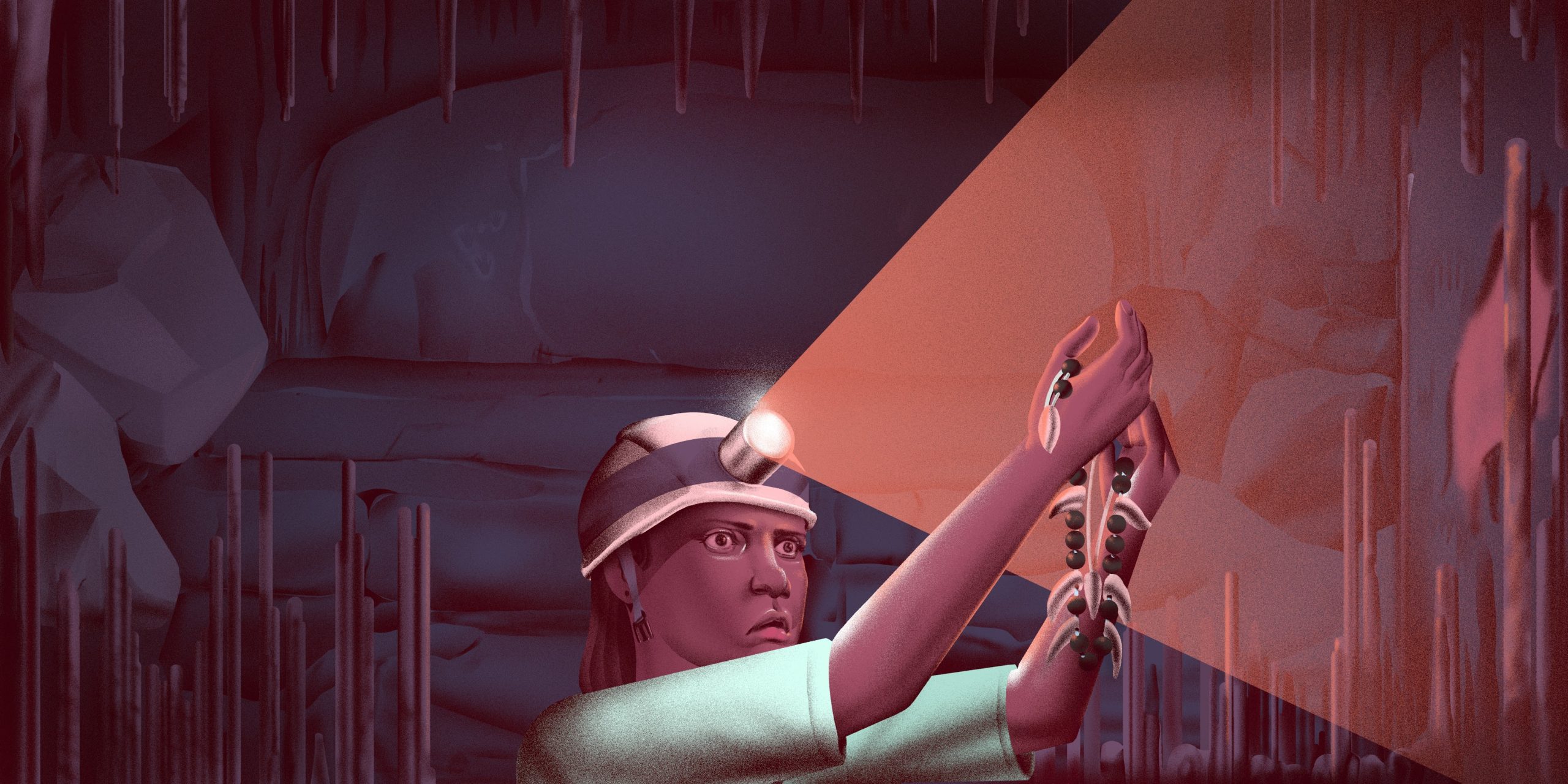Kindred: Neanderthal Life, Love, Death and Art
By Rebecca Wragg Sykes
Oct. 2020. 400p. Bloomsbury/Sigma
1. The Oldest Artwork Ever Found
In the late Eighties, twelve-year-old Bruno Kowalczewski was out hiking with his dad in Aveyron Valley, a forested region of steep gorges and rocky cliffs in southern France, when they were surprised to feel a faint breeze blowing out of the hillside from under ancient scree.
Bruno started clearing away the rocks to find out what was on the other side. After three years of digging, in February 1990, the Kowalczewskis and members of the local caving club broke through into a deep passageway that hadn’t been visited for a very long time. Stalactites drooped from the ceiling. Stalagmites clambered from the floor. They crept in, finding old animal bones, traces of bear activity, some pools of still water. And then, 1,102 feet inside the hill, they reached a place nobody like them had ever seen before; the passage opened into a chamber, and at its center there were two huge rings made up of hundreds of stalagmites. They’d been broken up deliberately, sometimes glazed in small fires, and arranged like the sign for infinity: ∞
The Kowalczewskis knew they’d found something extraordinary, and contacted archaeologist Francois Rouzaud, who, by carbon dating a burnt bear bone, suggested that the site was around 47,600 years old — so old that it was pushing the limits of carbon dating, which is only accurate up to 50,000 years. The rings they had discovered, one writer suggested, may have served as a map to the stars. But this age of revelations ended quickly, for in April 1999, while guiding colleagues through a nearby karstic network, Rouzaud had a heart attack and died. And with that, inquiry into the Bruniquel Cave came to an abrupt halt.
It wasn’t until recently — when Sophie Verheyden, an employee of the Royal Belgian Institute of Natural Sciences and a lifelong spelunker, happened to learn of the cave from an exhibition display at a nearby castle — that anyone explored the cave’s mysteries further. Verheyden wondered: why hadn’t anyone dated the broken stalagmites? She obtained permission to do so, and in 2013, found herself edging sideways through Bruno Kowalczewski’s tunnel. “I’m not very big,” she recalled, “and I had to put one arm before me and one behind to get through. It’s kind of magical, even without the structures.” Verheyden and colleagues used uranium-series dating to more definitively place the rings at around 176,500 years old — around 130,000 years older than any cave painting yet discovered.
This meant that the rings couldn’t have been made by us, Homo sapiens, as we only arrived in Europe around 50,000 years ago; and that when we did finally make it there, we may have found its hidden places and shelters filled with aura by artworks already tens of thousands of years old. What Bruno Kowalczewski had discovered in this chamber-gallery under the hill was an early masterpiece by a Neanderthal Richard Serra, or Robert Smithson. A space of expression, or ritual, or both.
Our aesthetic sensibility derives from deep within our lineage.
Describing the cave in her recently published book, Kindred, which synthesizes the latest findings on Neanderthals, Rebecca Wragg Sykes writes, “Monumental in scale and vision, it’s the first great art project, and at the same time truly weird, as in the original meaning of wyrd: destiny-changing power. Hominins might have made nothing like it for another 160,000 years, and the ‘why’ behind those stacked circles of burned stalagmites is lost in darkness.”
As Kindred shows, Neanderthal culture and ritual has only just begun to reveal itself. Thousands of generations ago, the forests rustled with Neanderthals, with European Homo heidelbergensis and antecessor, Indonesian Homo floresiensis — also known as the “hobbits” — Asian Homo luzonensis, African Homo naledi, rhodesiensis, ergaster, and other now-extinct human predecessors. Because they lived so long ago, and the details of their lives have been lost, we have long thought of these predecessors as primitive. But the Rings of Bruniquel suggest that, as far back as we can see, ancient human cultures have had some kind of desire for transcendence, a wish to leave their mark on the Earth; and that our aesthetic sensibility derives from deep within our lineage.
2. A Tale of Two Skulls
Bruniquel is an anomaly. So far, no other structures quite like it have turned up. Luckily, Neanderthals have left behind other far more subtle traces of their culture, offering clues to the sorts of relationships and societies they may have formed.
The most complete Neanderthal skeleton recovered to date was found in 1908, in Le Moustier, a town 80 miles from Bruniquel. As Wragg Sykes describes, Frenchman Jean Leysalles was digging up a rock shelter one afternoon when he hit a thick lower leg bone. He found more bones over the coming days, and eventually, one rainy evening, a shattered teenage skull: a boy, probably between 11 and 15 years, the same age Bruno Kowalczewski had been while clearing his tunnel. For decades, the Le Moustier 1 skeleton was on display at the Berlin Museum of Ethnography, but during the Second World War, its skull was hidden in a bunker in the Berlin Zoo, and later looted by the Red Army and carted off on a train to Moscow. The rest of the skeleton was left in the museum and blown up in a bombardment, and Le Moustier 1’s scattered parts were only reassembled in 1991, after the fall of the Berlin Wall. But when he was put back together again, something about him became apparent, something that no one had noticed before.
We know from surviving photographs and diaries that the boy was found in an unusual, disordered configuration: his skull facedown and tilted back, and his lower jaw ajar, slightly detached, in a sort of expression of ecstasy. But modern analysis showed that his whole head was flayed, the flesh torn away, his tongue removed, his jaw cut off and possibly beaten. The flesh from his right femur had also been removed. His body parts, however, had not been scattered. His skull and jaw were found together, with his face pressed directly against a large flat stone, suggesting he may have been buried.
There’s no clear evidence that Le Moustier 1 was murdered — only that his head was butchered after death, while other body parts that would make a more obvious meal were not. Wragg Sykes suggests that these may have been signposts of a primitive funerary ritual. In Kindred, she compares this to the example of our close relatives, the bonobos, writing about family groups mourning: “In one situation, following a baby’s natural death the group spent an entire morning eating much of the body, before the mother carried away the remnants on her back.”
She goes on to cover the mysteries of other skeletal discoveries in great depth. The most complete Neanderthal skull, for example, was found at the 130,000-year-old archaeological site of Krapina, in Croatia. It’s marked with a row of 35 short, mostly parallel cuts, running over the forehead, toward the back of the skull. They don’t fit any known butchery pattern, nor have any equivalent patterns been found on other hominin skulls. But shorter sequences have been found at Neanderthal sites elsewhere: seven notches on a raven bone from Zaskalnaya, Crimea, and nine incisions, plus eight tiny dashes, on a hyaena bone from Les Pradelles, in Haute-Loire. These may be forms of primitive artwork, or perhaps an early form of communication. Whatever they signify, these 35 cuts are the longest sequence of Neanderthal code ever found.

Faint traces of symbols have also been revealed on animal remains. At various Neanderthal sites in southern Europe, archaeologists have found cut-off talons that may have been treasured as adornments or charms. Over a century ago, eight talons from white-tailed eagles — the largest eagle in Europe and most of Asia, with an eight-foot wingspan — were found in close proximity at Kaprina. In 2015, it was proposed that they were parts of a necklace. In 2020, a mixed pigment of red and yellow minerals, charcoal, and clay was detected on one of these talons, meaning that it had once been painted. Like the Rings of Bruniquel, this necklace suggests that ancient humans also engaged in symbolic activities, and may have been dressing up and decorating their bodies to express their status or identity.
White-tailed eagles are awe-inspiring hunters that dominated the skies of ancient Europe, and their talons may have been coveted because they were hard to obtain, or fearsomely beautiful, or perhaps because they were thought to confer certain favors or powers. The discovery that the longest known sequence of Neanderthal markings appears etched into the Kaprina skull likewise implies that skulls were valued, whether for ritualistic reasons or as trophies or memento mori — or for some other reason beyond our imagination. Collectively, these fragments suggest Neanderthal lives, like our own, involved art and ritual, and the maintenance of complex relationships, both personal and sexual, with one another. Unlike modern humans, however, they also would have had the opportunity to meet and interact with other hominins.
3. The Cave at the Edge of the World
The story of human evolution may be riddled with mystery, but we do know for sure that different species of humans once roamed the world simultaneously — and that many of these populations crossed paths. The evidence isn’t found in cultural artifacts or sites — we have yet to find any intra-hominin collaborative art works — but rather in the story told by ancient DNA.
In 2010, Svante Pääbo, director of the Max Planck Institute for Evolutionary Anthropology in Leipzig, led a team that mapped out the Neanderthal genome using DNA from their bone fragments. He discovered evidence that they must have interbred with Homo sapiens: all non-African populations contain some Neanderthal DNA, up to two or three percent, because after leaving sub-Saharan Africa, our ancestors met and had children with Neanderthals during at least three, and perhaps up to half-a-dozen, distinct periods.
That same year, Pääbo and his colleagues also uncovered something unexpected in a small fragment of toe, recovered from Denisova Cave in Russia’s Altai Mountains, which was known to have been frequented by Neanderthals. In this genome, the researchers found an entirely new “ghost” population of ancient humans: the Denisovans, about whom still very little is known. The Denisovans are thought to have spread across East Asia, and to have had an unusual ability to survive at high altitudes. Genetic analysis has shown that many Chinese and South-East Asians have a small amount of Denisovan in them, and that up to five percent of Aboriginal Australians and six percent of New Guinean DNA is Denisovan. Before they disappeared, they were having sex with us.
An even more surprising fragment of bone was collected in the same cave in 2012, and later found to be Neanderthal: a part of a limb of a young teenage girl who lived about 90,000 years ago. In 2018, further genetic analysis revealed that while her mitochondrial DNA (mtDNA) came from a Neanderthal mother, her nuclear DNA showed that her father had been a Denisovan. She was nicknamed Denny. Given that only a couple hundred Neanderthals have ever been found, and the entire Denisovan fossil record would fit inside a box of American Spirits, this little girl disproved prior assumptions about our ancestry. Denny’s discovery is so rare, the researchers didn’t initially believe it. “The implications are staggering,” Wragg Sykes writes. “It was assumed that interbreeding was rare, and direct evidence would only ever lurk in the genetic gloom, many generations back from the bones we study. Actually finding the child of a union between different kinds of hominin implies it can’t have been that uncommon.” Furthermore, studies of her Denisovan father’s genes have also turned up shards of Neanderthal DNA. This means that interbreeding had also taken place many generations before her birth, and perhaps in the same cave; such were the telenovela lives of the ancient humans.
This is just one of many examples of how sexual choices made tens or hundreds of thousands of years ago in faraway caves can dramatically affect our lives today.
Denisova cave lies on the eastern boundary of the Neanderthals’ homelands, which reached from North Wales down to the fringes of the Arabian deserts and across to China. These mountains of what is now Russia were the western boundary of the Denisovans’ range. No Neanderthal DNA has ever been found farther east, and no Denisovan farther west. “Perhaps,” Wragg Sykes writes, “this cave was literally at the edge of their two worlds.” They may well have traveled from far away before passing through the same cave, at the same time, by accident or design: Denny’s mother’s mtDNA shows she was more closely related to Neanderthals found thousands of miles away in Croatia than to others found in Denisova, in the very same cave. While we’ll never know in what circumstances children like Denny were conceived, we can tell they were raised and cared for — otherwise they would not have survived into adolescence, and would not have been able to carry on the lines we now trace in our own genomes.
The genes that we’ve inherited from Neanderthals and Denisovans, and likely other populations besides, have both helped and hindered us. A particular Denisovan gene, for instance, helps Tibetans to cope with low oxygen levels high up in the Himalayas. Every incarnation of the Dalai Llama will have carried a lot of Denisovan DNA. Neanderthal genes have been linked to weight gain and addiction; and while these are no longer desirable traits today, gluttony would once have helped with thermal efficiency and staving off starvation. Last fall, during the pandemic, a new research project led by Svante Pääbo and his colleague Hugo Zeberg identified two Neanderthal “haplotypes,” or sets of DNA variations, that affect our bodies’ response to Covid-19. One, found on the 3rd of our 46 chromosomes, doubles the likelihood of needing intensive care if infected with the coronavirus. It’s thought to encode a protein that helps the Sars-CoV-2 virus hijack cells, and to be involved in the production of cytokine signaling proteins that regulate the immune system. Another Neanderthal haplotype, found on the 12th chromosome, appears to lower the chance of serious illness by a fifth. This is just one of many examples of how sexual choices made tens or hundreds of thousands of years ago in faraway caves can dramatically affect our lives today.
4. The Valley of Life
In the Neandertal (Neander Valley), a limestone region of Germany in North Rhine-Westphalia, in the mid-19th century, a group of unusual hominin fossils was found in a quarry. Soon afterwards, the local natural historian Johann Carl Fuhlrott and the anatomist Hermann Schaaffhausen declared that these bones must have come from a vanished human species. It was 1859, the same year that Charles Darwin and Alfred Wallace announced their theories of natural selection. Darwin himself, the following decade, would hold a Neanderthal skull in his hands. All we know of his response is that he found it “wonderful.” He always preferred to remain reticent on the question of human evolution. But today, 21st-century genetics allow us to peer through time in ways not possible before. Like tribes of Neanderthal artists building rings lit by flames in the caves, we can draw maps of our spiraling helixes and how they’ve evolved over time, in search of what we are, and how we came to be.
We still have much in common, it seems, with Neanderthals. The Rings of Bruniquel suggest a shared desire for transcendent expression. The skulls from Le Moustier and Kaprina may reveal a wish to be remembered, and perhaps to honor the dead; they could also be read as signs of our enduring cruelty to our fellow man. But it’s clear that we share a drive to explore as much of the world as possible, whether journeying across the vast, harsh landscapes of Pleistocene Europe, or tracking the ghosts in our blood through long sequences of numbers on a screen. That so much of our Neanderthal and Denisovan lineage has been uncovered in less than a decade, and from so few fossils, suggests there was much more interbreeding — and many more hybrid beings — than we may ever know. Imagine what else hides inside of us, just waiting to be discovered.



